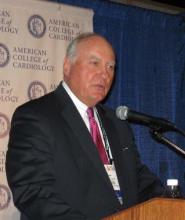CHICAGO – An investigational fully human monoclonal antibody slashed low-density lipoprotein cholesterol levels by up to 72% in a phase II clinical trial in dyslipidemic patients not at goal despite already being on a statin.
The study results for the monoclonal antibody known for now as SAR236553/REGN727 caused head-swiveling and double-takes at the annual meeting of the American College of Cardiology.
"We need to understand: This is a ‘wow.’ It could be a game changer in the future," commented scientific session program committee cochair Dr. Rick A. Nishimura, professor of medicine at the Mayo Clinic, Rochester, Minn. He was referring to the randomized, double-blind, placebo-controlled, 12-week phase II study presented by James M. McKenney, Pharm.D. The trial involved 183 patients with an LDL cholesterol level above the target of 100 mg/dL despite an average of 7 years of statin therapy. The participants remained on atorvastatin at 10, 20, or 40 mg/day as background therapy while being randomized to 12 weeks of subcutaneously administered SAR236553/REGN727 at one of five dosing regimens or to placebo.
At the most effective dosing schedule – 150 mg once every 2 weeks – LDL dropped by a mean of 72% at 12 weeks, from a baseline of 124 mg/dL. Within the first 2 weeks the LDL level had already fallen by 60%.
A clear dose-response relationship was evident, with dosing at 50 and 100 mg once every 2 weeks eliciting mean 40% and 64% LDL reductions, respectively, reported Dr. McKenney, chief executive officer at National Clinical Research, Richmond, Va.
"This is monumental clearance of LDL. It’s just unheard of, especially considering the statin these patients were on should already have produced about a 40% decrease in LDL," he said. "If the drug pans out, if it continues to show efficacy and especially if it shows safety, we may be moving into a new era in the treatment of lipid disorders and, more importantly, in the reduction of heart disease in this country."
At the optimal dosing regimen of SAR236553/REGN727, an agent Dr. McKenney referred to as "553" for the sake of brevity, patients also had mean reductions of 27% in lipoprotein(a), 56% in apolipoprotein B, and 63% in non-HDL (non-high-density lipoprotein) cholesterol, along with a nonsignificant trend for lower triglycerides.
The monoclonal antibody is highly specific for proprotein convertase subtilisin/kexin type 9 serine protease (PCSK9). This protein plays a pivotal role in the degradation of LDL receptors, thereby interfering with cholesterol uptake by the liver.
Treatment with 553 was well tolerated; the most common side effect was mild, transient, injection site reactions. Importantly, given that patients were already on statin therapy, there were no increases in hepatic or muscle-related enzymes.
The one significant adverse event was a case of biopsy-confirmed leukocytoclastic vasculitis occurring 9 days after a patient received a first 300-mg injection of 553. The reaction took the form of a rash on the arms, legs, and abdomen, with no other organ involvement. It responded quickly to drug withdrawal and initiation of prednisone. No other cases of leukocytoclastic vasculitis occurred in any other 553-treated patients, including those who participated in three just-published phase I studies (N. Engl. J. Med. 2012;366:1108-18).
No antidrug antibodies were detected shortly after the patient developed leukocytoclastic vasculitis; however, low-level titers were found at week 20. The patient remained negative for antinuclear antibodies through 6 months of follow-up blood tests.
Leukocytoclastic vasculitis is a rare, generally benign disease with an incidence of 40-60 cases per million persons per year. Medications are identified as the cause of about 20% of cases, with antibiotics and NSAIDs being among the most common offenders. Leukocytoclastic vasculitis is listed as a possible adverse event in the product labeling for most monoclonal antibody therapies, Dr. McKenney noted.
Large phase III clinical trials will begin enrollment later this year. They will focus on patients at high cardiovascular risk, including those with familial hypercholesterolemia and/or prior vascular events who aren’t at goal despite statin therapy.
Coinvestigator Dr. Dean J. Kereiakes said in an interview that one of the most intriguing observations in the phase II study was that mean LDL levels were still on their way down when 553 was stopped after 12 weeks.
"We didn’t hit the nadir. The LDL hadn’t plateaued. If we had taken patients out to 18-20 weeks, we might have seen an even greater delta," according to Dr. Kereiakes of Christ Hospital, Cincinnati.
He sees the target population for 553 as being the large number of patients who can’t reach their LDL target despite maximum doses of currently approved medications, as well as those who can’t do so because they can’t tolerate maximum doses of those drugs.


